Research on Crystal Structure Evolution and Failure Mechanism during TSV-Metal Line Electromigration Process
Abstract
:1. Introduction
2. TSV Electromigration Experiment
2.1. Test Samples
2.2. Electromigration Test Platform
2.3. Microstructure Analysis
3. Results Discussion and Analysis
3.1. Effect of Cu Crystal Orientation on TSV-Metal Liner Electromigration
3.2. The Influence of Inter-Grain Misorientation on TSV-Metal Line Electromigration
3.2.1. Conditions of 5 × 105 A/cm2 Current Density
3.2.2. Conditions of 1 × 106 A/cm2 Current Density
4. Conclusions
- (a)
- During the process of electromigration, the flow of current induces current density gradients and localized heating effects, leading to lattice distortions. These distortions result in changes to the microstructure within the grains of the TSV-metal line and the bottom metal line, consequently influencing grain orientation alterations. Such alterations exhibit a significant dependency on the angle between crystal orientation and the direction of the current. When the angle between the current direction and grain orientations [001] or [010] is larger, crystals are more prone to deviate towards directions with a smaller angle between the grain orientation and the current. This propensity arises because the current direction is precisely perpendicular to the <100> crystal plane, and within this crystal plane family, the atomic density is at its lowest, minimizing the energy required for electron migration. Hence, crystals tend to rotate toward the direction with the lowest energy requirement for electron migration.
- (b)
- During the electromigration process in TSV samples, the regions where voids are more likely to form are typically located at the TSV-metal line and near its corners, especially in the upper section of the anode TSV, where a significant number of voids tend to develop. This phenomenon is influenced by the flow direction of grains and misorientation. The TSV-metal line area is typically characterized by high misorientation levels, and void formation tends to occur in regions with higher misorientation levels, particularly in areas where the grain boundary misorientation values were relatively larger before the experiment.
5. Comparative Discussion of Other Studies
- In-depth electromigration study: this paper extensively investigates the crystal orientation changes and electromigration failure in TSV-metal line structures induced by electrical currents, providing a deeper insight into the understanding of the failure mechanisms.
- Exploration of the angle’s impact on crystal deviation: it emphasizes the significance of the angle between the direction of current flow and grain orientation in influencing crystal deviation, enhancing a detailed understanding of the failure mechanism.
- Focus on the impact of high misorientation: it highlights the contribution of stress gradients induced by high misorientation to failure, providing valuable information for practical engineering applications.
Author Contributions
Funding
Data Availability Statement
Conflicts of Interest
References
- Lau, J.H. Overview and outlook of through-silicon via (TSV) and 3D integrations. Microelectron. Int. 2011, 62, 437–449. [Google Scholar] [CrossRef]
- Tu, K.N. Reliability challenges in 3D IC packaging technology. Microelectron. Reliab. 2011, 51, 517–523. [Google Scholar] [CrossRef]
- Xu, Z.; Lu, J.Q. High-speed design and broadband modeling of through-strata-vias (TSVs) in 3D integration. IEEE Trans. Compon. Packag. Manuf. Technol. 2011, 1, 154–162. [Google Scholar] [CrossRef]
- Jang, Y.J.; Sharma, A.; Jung, J.P. Advanced 3D Through-Si-Via and Solder Bumping Technology: A Review. Materials 2023, 16, 7652. [Google Scholar] [CrossRef] [PubMed]
- Wang, J.; Duan, F.; Lv, Z.; Chen, S.; Yang, X.; Chen, H.; Liu, J. A Short Review of Through-Silicon via (TSV) Interconnects: Metrology and Analysis. Appl. Sci. 2023, 13, 8301. [Google Scholar] [CrossRef]
- Tian, W.; Wu, S.; Li, W. Research of Vertical via Based on Silicon, Ceramic and Glass. Micromachines 2023, 14, 1391. [Google Scholar] [CrossRef] [PubMed]
- Chang, Y.-J.; Ko, C.-T.; Yu, T.-H.; Chiang, C.-H.; Chen, K.-N. Backside-process-induced junction leakage and process improvement of cu TSV based on Cu/Sn and BCB hybrid bonding. IEEE Electron. Device Lett. 2013, 34, 435–437. [Google Scholar] [CrossRef]
- Nakamura, T.; Kitada, H.; Mizushima, Y.; Maeda, N.; Fujimoto, K.; Ohba, T. Comparative study of side-wall roughness effects on leakage currents in through-silicon via interconnects. In Proceedings of the IEEE International 3D Systems Integration Conference (3D IC), Osaka, Japan, 31 January–2 February 2012; pp. 1–4. [Google Scholar]
- De Wolf, I.; Jacobs, K.J.; Orozco, A. Magnetic field imaging and light induced capacitance alteration for failure analysis of cu-TSV interconnects. Microelectron. Reliab. 2020, 114, 113780. [Google Scholar] [CrossRef]
- Rui, M.; Meiying, S.; Xiaofang, L. Finite Element Analysis of Influencing Factors on TSV Electromigration. Electron. Compon. Mater. 2019, 38, 93–97. [Google Scholar]
- Chen, S.; Jian, X.; Li, K. Effect of temperature cycling on the leakage mechanism of TSV liner. Microelectron. Reliab. 2023, 141, 114889. [Google Scholar] [CrossRef]
- Gousseau, S.; Bouchu, D.; Farcy, A.; Montmitonnet, P.; Inal, K.; Bay, F.; Zelsmann, M.; Picard, E.; Salaun, M. Electromigration-induced failure in operando characterization of 3D interconnects: Microstructure influence. Microelectron. Reliab. 2015, 55, 1205–1213. [Google Scholar] [CrossRef]
- Zhaohui, C. High-Power LED Packaging and Silicon Through-Silicon via (TSV) Three-Dimensional Packaging Process and Reliability Numerical Simulation and Experimental Study; Shanghai Jiao Tong University: Shanghai, China, 2012. [Google Scholar]
- Pak, J.; Pathak, M.; Lim, S.K.; Pan, D.Z. Modeling of electromigration in through-silicon-via based 3D IC. In Proceedings of the IEEE Electronic Components & Technology Conference, Buena Vista, FL, USA, 31 May–3 June 2011; pp. 1420–1427. [Google Scholar]
- Frank, T.; Moreau, S.; Chappaz, C.; Arnaud, L.; Leduc, P.; Thuaire, A.; Anghel, L. Electromigration behavior of 3D-IC TSV interconnects. In Proceedings of the IEEE Electronic Components and Technology Conference, San Diego, CA, USA, 29 May–1 June 2012; pp. 326–330. [Google Scholar]
- Zisser, W.; Ceric, H.; Weinbub, J.; Selberherr, S. Electromigration reliability of open TSV structures. Microelectron. Reliab. 2014, 54, 2133–2137. [Google Scholar] [CrossRef]
- Rovitto, M.; Zisser, W.H.; Ceric, H.; Grasser, T. Electromigration modelling of void nucleation in open Cu-TSVs. In Proceedings of the IEEE 16th International Conference on Thermal, Mechanical and Multi-Physics Simulation and Experiments in Microelectronics and Microsystems, Virtual, 19–22 April 2015; pp. 1–5. [Google Scholar]
- Hao, N. Reliability Simulation and Lifetime Prediction of TSV Structures under Multi-Stress Coupling; Xidian University: Xi’an, China, 2022. [Google Scholar]
- Bing, L. Research on the Nanomachining Mechanism Based on Scanning Electron Microscopy; Tianjin University: Tianjin, China, 2015. [Google Scholar]
- Yongmei, Y. Study on the Microstructure and Texture Evolution of Fe-3%Si Steel Strip in TSCR Process; Northeastern University: Shenyang, China, 2008. [Google Scholar]
- Fan, P. Research on Phase Identification and Orientation Analysis Methods Using Electron Backscatter Diffraction (EBSD); University of Chinese Academy of Sciences: Beijing, China, 2021. [Google Scholar]
- Ping, Y. Electron Backscatter Diffraction Technology and Its Applications; Metallurgical Industry Press: Beijing, China, 2007; pp. 51–53. [Google Scholar]
- Yulong, L. Research on the Plane Strain Plastic Deformation Mechanism and Microstructure Evolution of Ni-Ti-Fe Shape Memory Alloy; Harbin Engineering University: Harbin, China, 2017. [Google Scholar]
- Yanling, Y. Preparation of Nickel and Nickel-Iron Nanomaterials and Research on Cold Rolling-Annealing Textures; Northeastern University: Shenyang, China, 2009. [Google Scholar]
- Yu, T. The Influence of Grain Number and Intermetallic Compounds on the Electromigration Behavior of Sn-Based Solder Joints; Beijing University of Technology: Beijing, China, 2020. [Google Scholar]
- Shihua, Y. Micro-Mechanical Behavior of SnAgCu/Cu Solder Joints with Limited Grains; Harbin Institute of Technology: Harbin, China, 2010. [Google Scholar]
- Zhao, J.; Huang, M.; Zhao, N.; Zhang, Z. Effect of Sn grain orientation on Cu diffusion in SnAgCu solder interconnect undergoing electromigration. In Proceedings of the 16th International Conference on Electronic Packaging Technology, Changsha, China, 11–14 August 2015; pp. 1275–1278. [Google Scholar]
- Chen, J.Q.; Liu, K.L.; Guo, J.D.; Ma, H.C.; Wei, S.; Shang, J.K. Electromigration anisotropy introduced by tin orientation in solder joints. J. Alloys Compd. 2017, 703, 264–271. [Google Scholar] [CrossRef]
- Shen, Y.A.; Chen, C. Effect of Sn grain orientation on formation of Cu6Sn5 intermetallic compounds during electromigration. Scr. Mater. 2017, 128, 6–9. [Google Scholar] [CrossRef]
- Lu, M.; Shih, D.Y.; Lauro, P.; Goldsmith, C.; Henderson, D.W. Effect of Sn grain orientation on electromigration degradation mechanism in high Sn-based Pb-free solders. Appl. Phys. Lett. 2008, 92, 211909. [Google Scholar] [CrossRef]
- Deng, S.; Li, R.; Yuan, T. The preferential growth behaviors of the intermetallics at the W/Co interface during spark plasma sintering. Appl. Phys. Lett. 2020, 117, 194102. [Google Scholar] [CrossRef]
- Baolin, G. Research on Electromigration Effects in Copper Interconnects with Lateral Redundancy; Dalian University of Technology: Dalian, China, 2016. [Google Scholar]
- Si, C. Research on the TSV-Cu Extrusion Behavior in Key Structures of Three-Dimensional Electronic Packaging; Beijing University of Technology: Beijing, China, 2017. [Google Scholar]
- Zhilyaev, A.P.; Sergeev, S.N.; Langdon, T.G. Electron backscatter diffraction (EBSD) microstructure evolution in HPT copper annealed at a low temperature. J. Mater. Res. Technol. 2014, 3, 338–343. [Google Scholar] [CrossRef]
- Jasionowski, R.; Zasada, D.; Polkowski, W. EBSD strain analysis of CuZn10 alloy in as-cast state and after plastic working and annealing during cavitational wear. Arch. Foundry Eng. 2013, 13, 53–60. [Google Scholar]
- Wei, Z.X. Microstructure Evolution and Mechanism Study of Copper-Filled Silicon Vias under Thermal and Electrical Conditions; Beijing University of Technology: Beijing, China, 2019. [Google Scholar]
- Zhang, Y.; Yu, S.; Su, D.; Shen, Z. Finite element modeling on electromigration of TSV interconnect in 3D package. In Proceedings of the IEEE 20th Electronics Packaging Technology Conference (EPTC), Singapore, 4–7 December 2018. [Google Scholar]
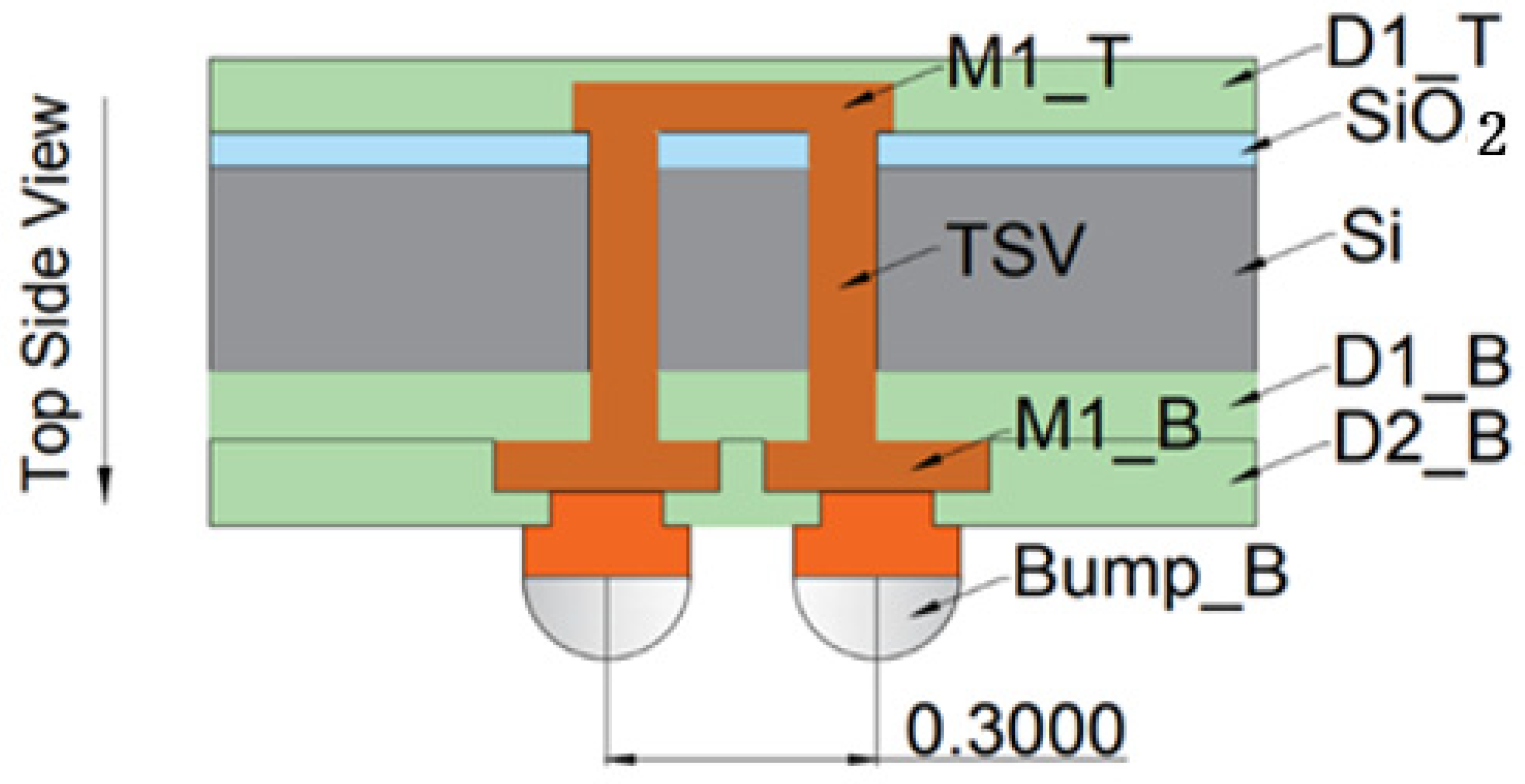
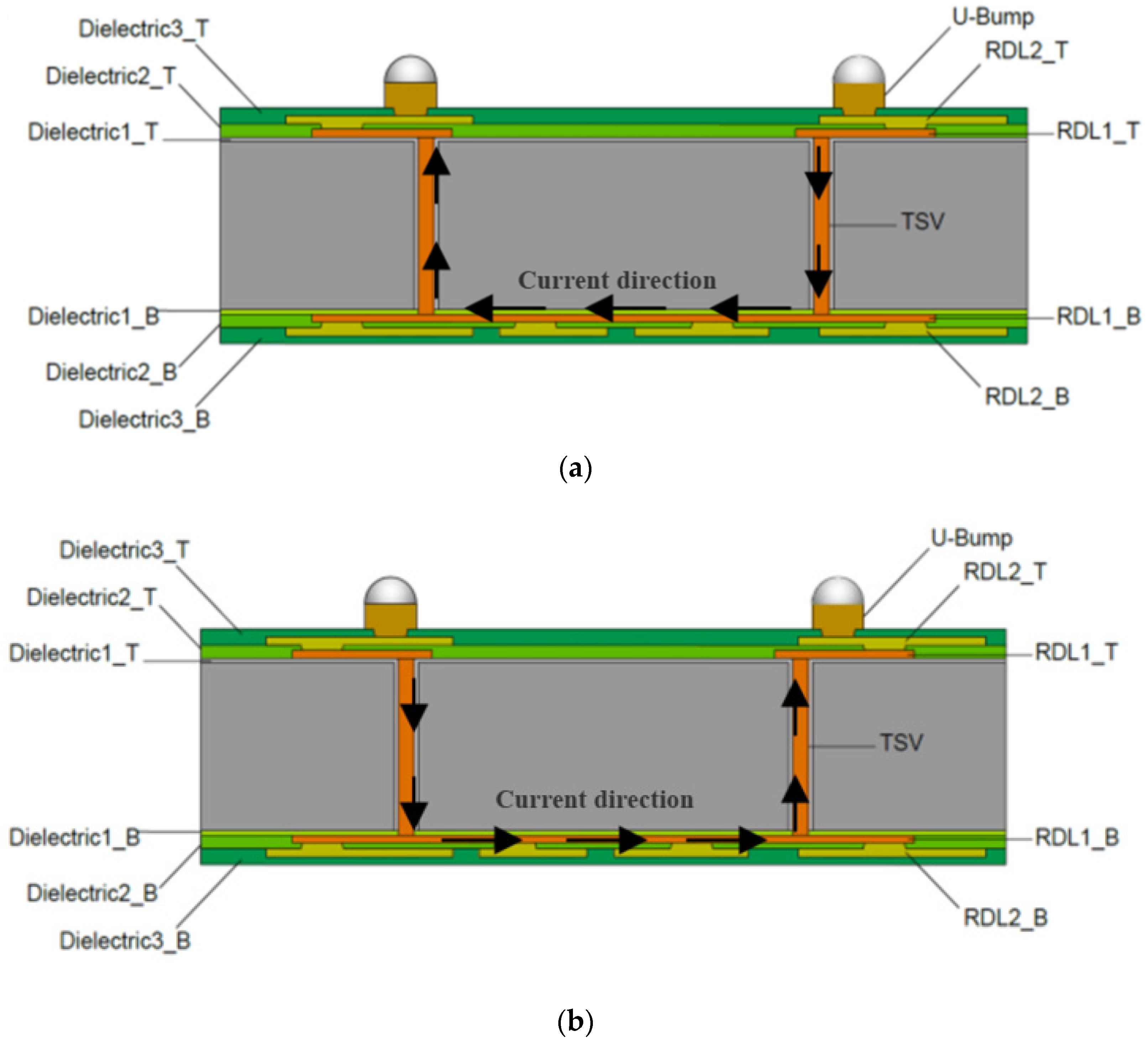

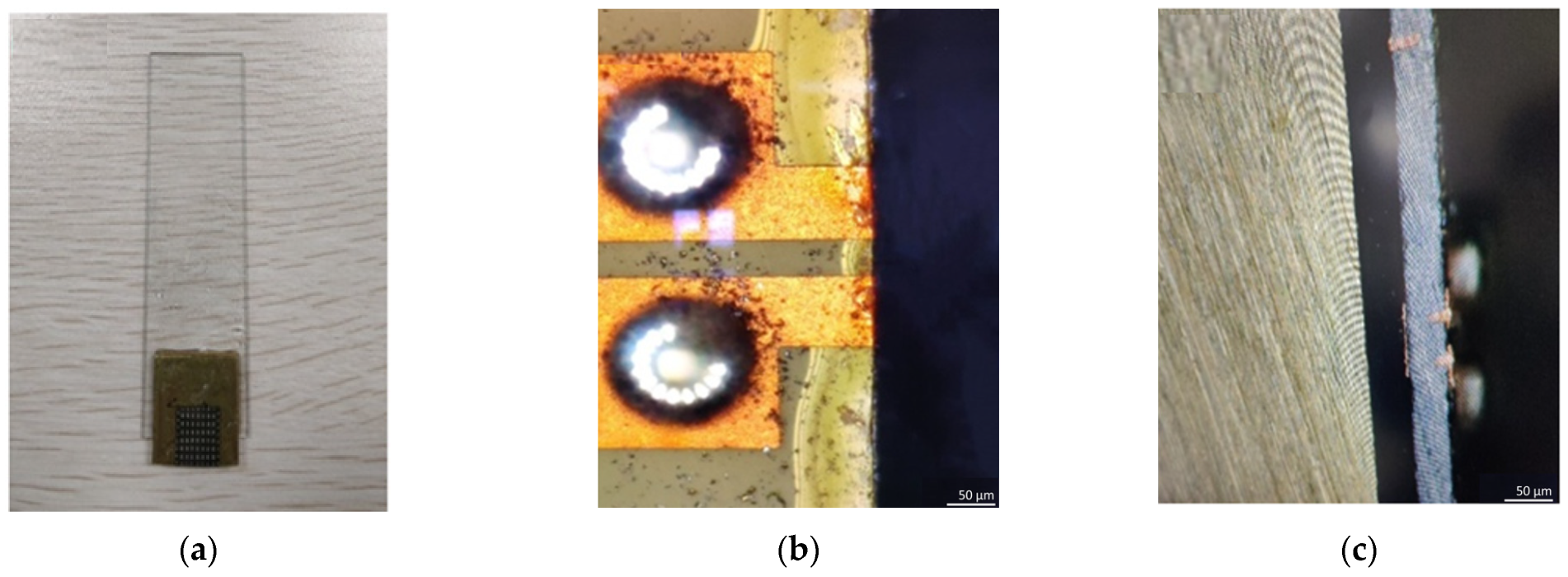

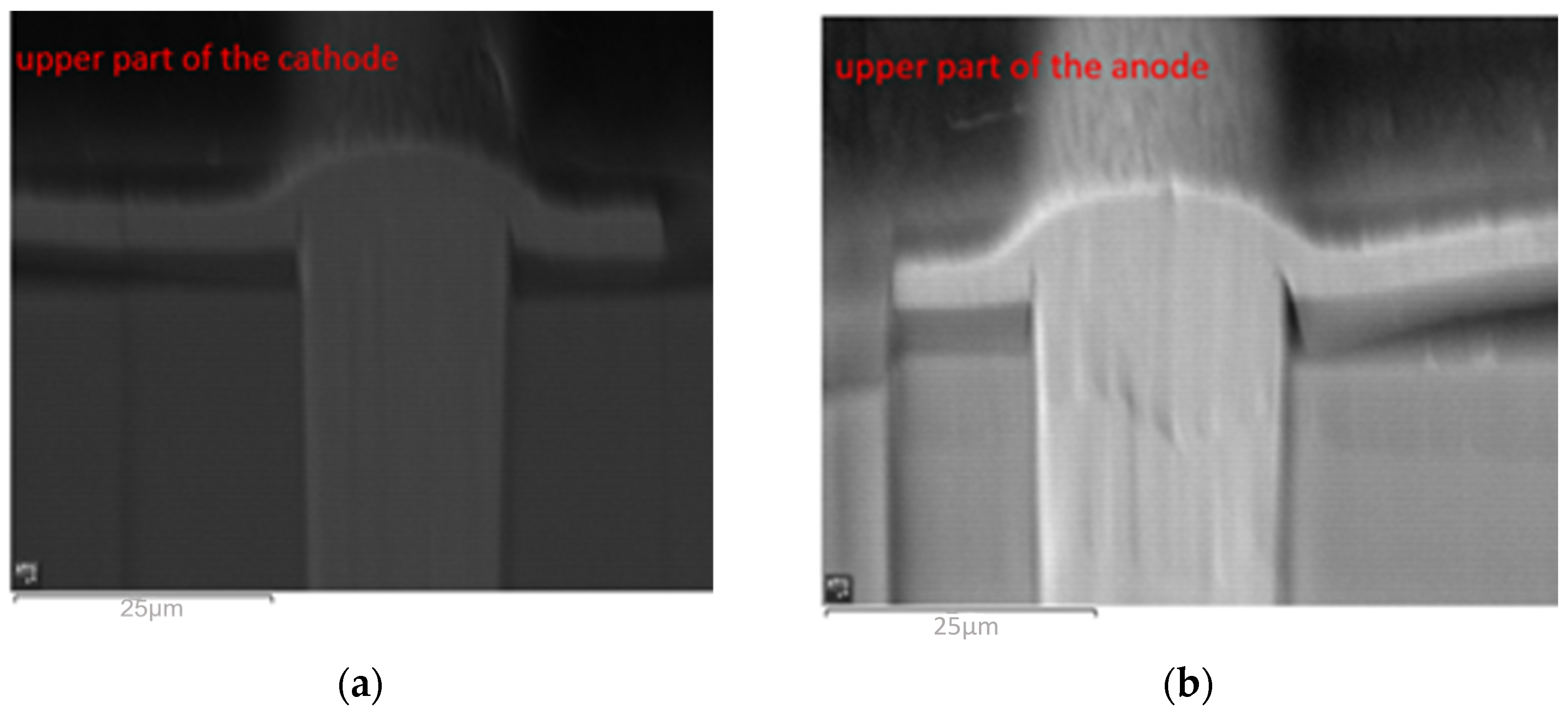
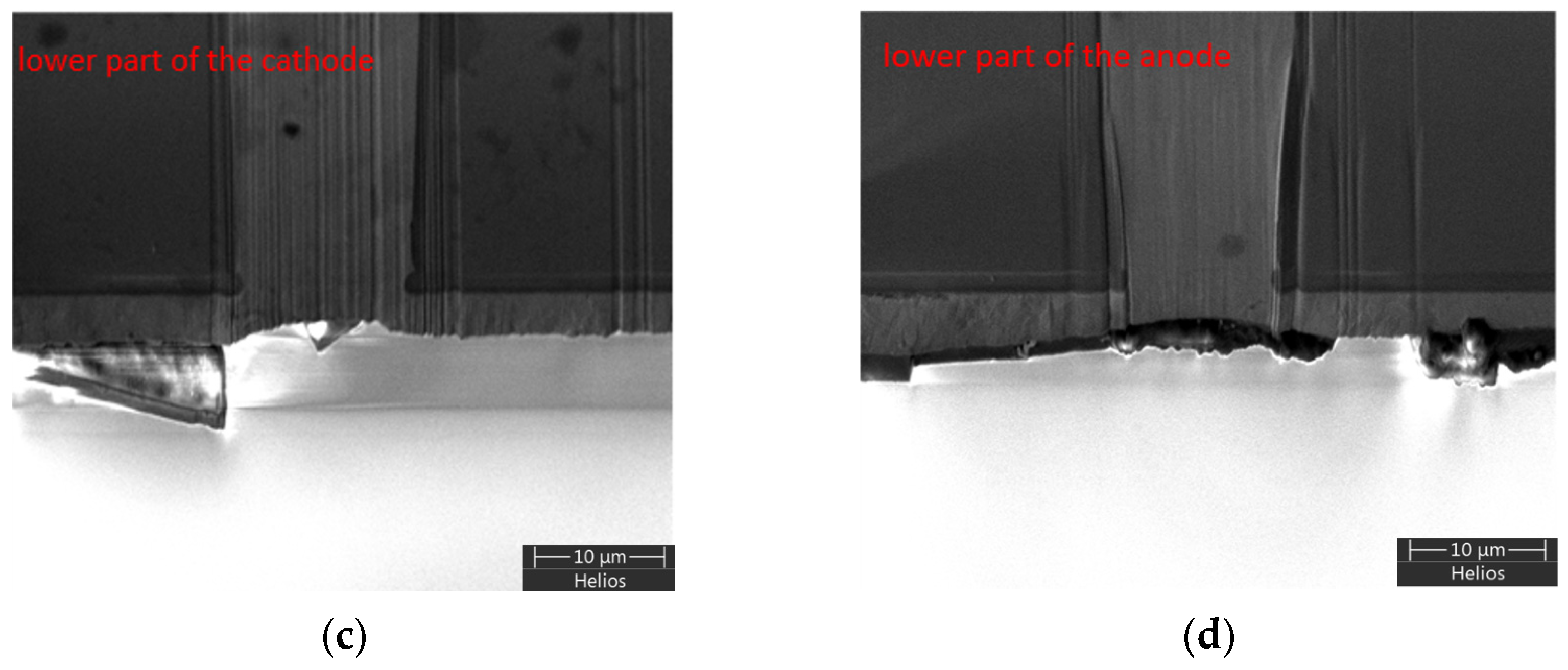






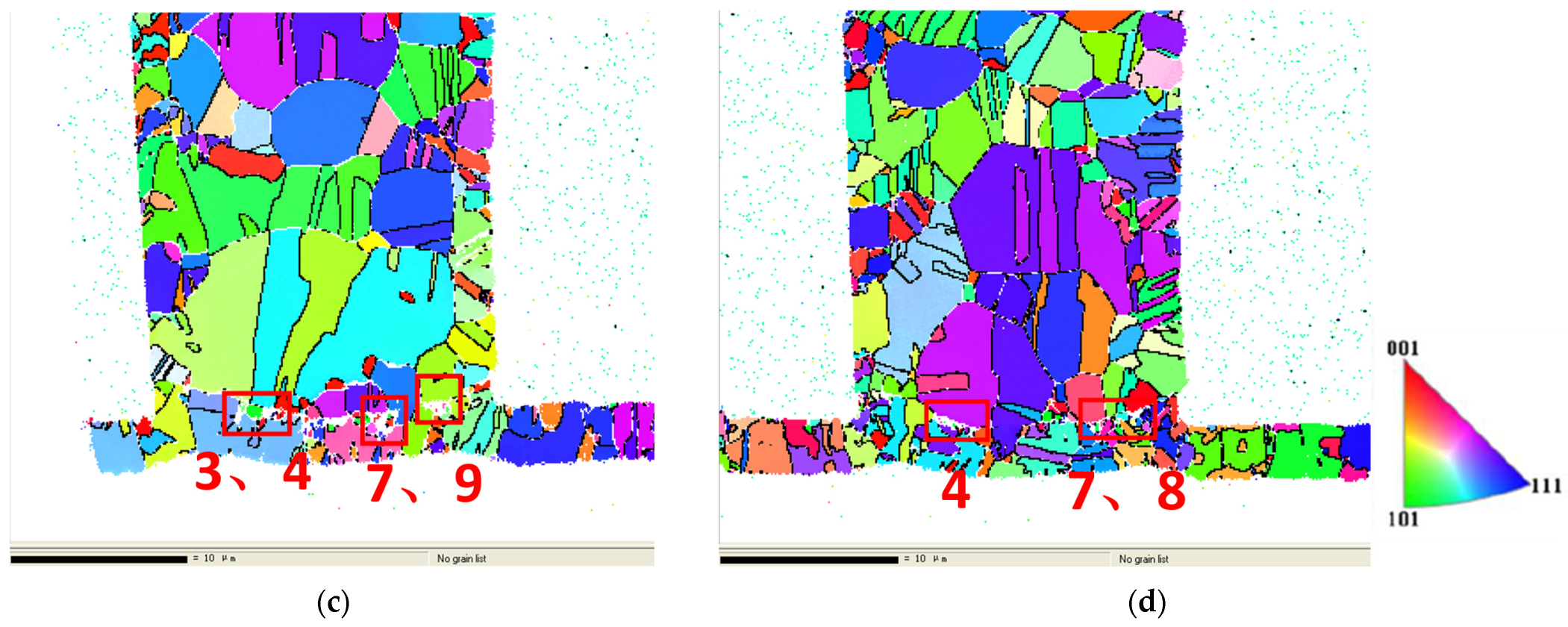

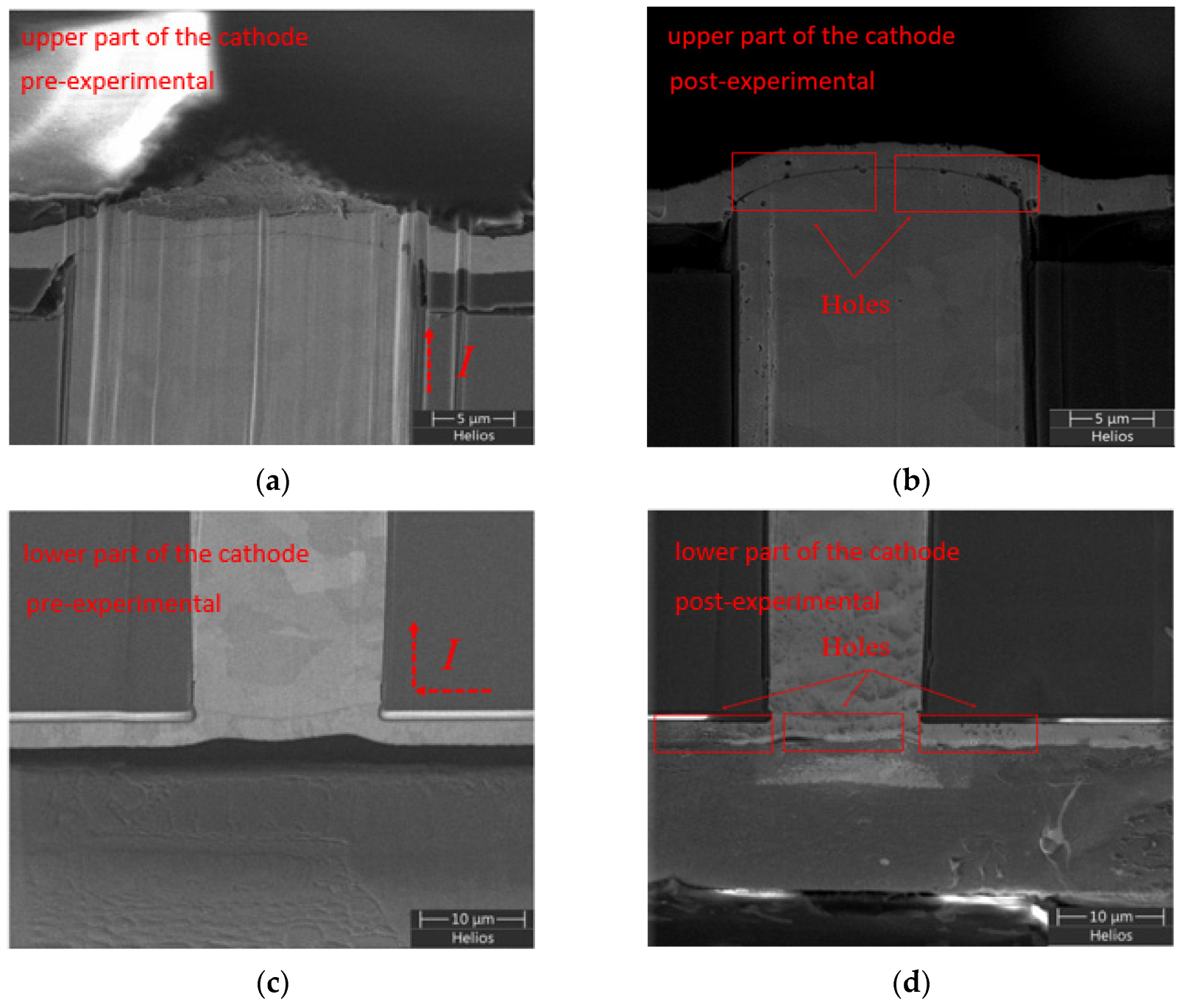





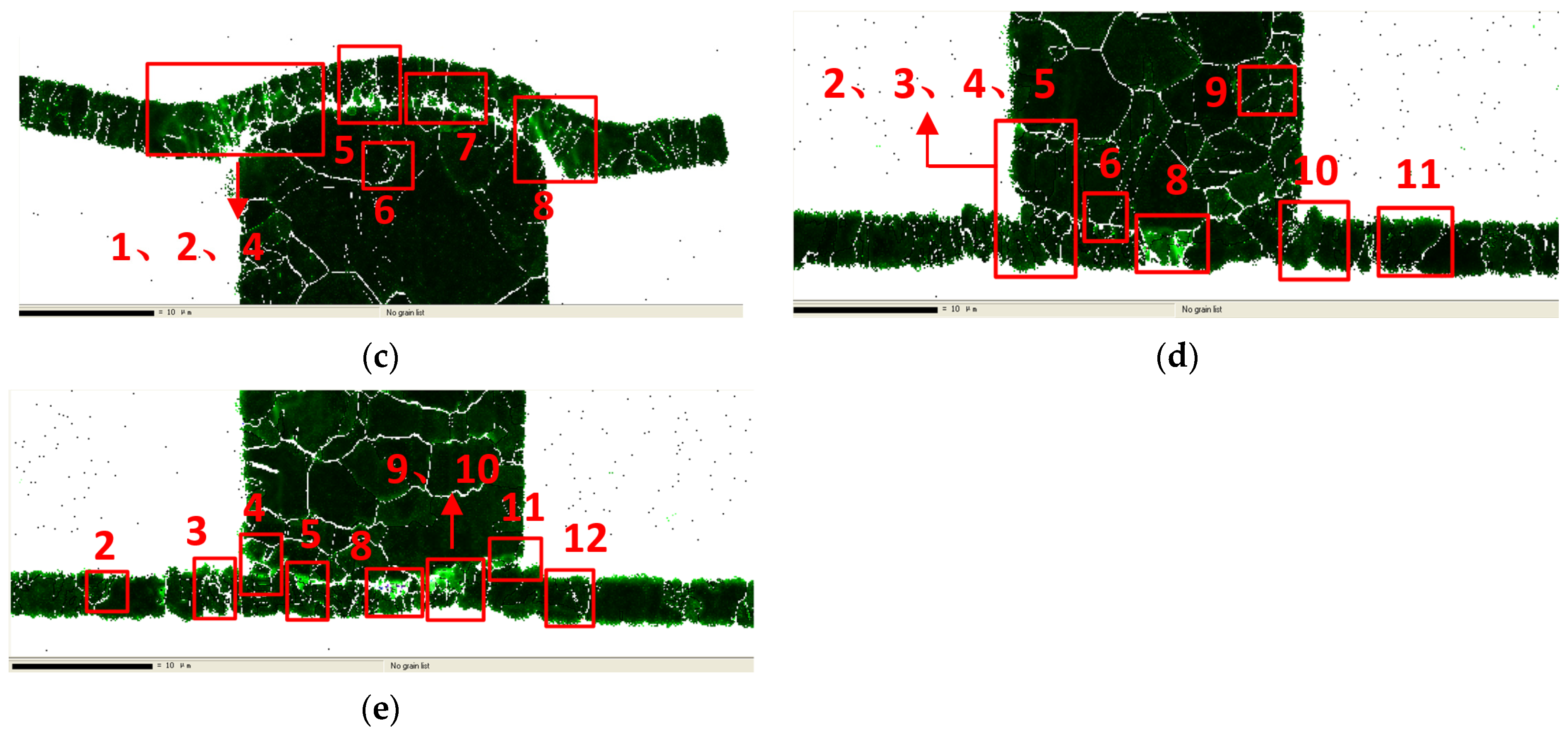
| Layer | Material | Thickness (μm) | Tolerance (μm) |
|---|---|---|---|
| D1_T | JSR5100 | 5 | ±1.5 |
| M1_T | Cu | 3 | ±1 |
| SiO2 | SiO2 | 2 | ±10% |
| TSV | Cu | 100 | ±10 |
| D1_B | JSR5100 | 3.5 | ±1.5 |
| M1_B | Cu | 3 | ±1 |
| D2_B | JSR5100 | 5 | ±1.5 |
| Bump | Cu | 50 | ±5 |
| Ni | 3 | ±1 | |
| SnAg | 27 | ±3 |
| Sample | Current | Temperature | Time |
|---|---|---|---|
| A | 0.159 A (current density 1.0 × 105 A/cm2) | 100 °C | 210 h |
| B | 0.785 A (current density 5.0 × 105 A/cm2) | 100 °C | 210 h |
| C | 1.59 A (current density 1.0 × 106 A/cm2) | 100 °C | 210 h |
| D | 1.59 A (current density 1.0 × 106 A/cm2) | 100 °C | 210 h |
| Placement | Figure 12a Misorientation of Grain Boundaries (°) | Figure 12b Misorientation of Grain Boundaries (°) |
|---|---|---|
| 1 | 27.63 | 40.13 |
| 2 | 38.94 | 38.80 |
| 3 | 59.88 | 37.57 |
| 4 | 59.96 | 59.96 |
| 5 | 39.05 | 31.36 |
| 6 | 39.13 | 38.43 |
| 7 | 55.59 | 51.66 |
| 8 | 25.40 | 59.94 |
| 9 | 59.61 | 44.25 |
| 10 | 38.77 | 35.59 |
| Placement | Figure 15a Misorientation of Grain Boundaries (°) | Figure 15c Misorientation of Grain Boundaries (°) |
|---|---|---|
| 1 | 52.82 | 29.04 |
| 2 | 59.93 | 38.91 |
| 3 | 38.96 | 31.42 |
| 4 | 25.89 | 34.51 |
| 5 | 25.44 | 28.95 |
| 6 | 48.5 | 24.24 |
| 7 | 36.59 | 48.02 |
| 8 | 37.05 | 40 |
| 9 | \ | 39 |
| Placement | Figure 17a Misorientation of Grain Boundaries (°) | Figure 17c Misorientation of Grain Boundaries (°) | Figure 17e Misorientation of Grain Boundaries (°) |
|---|---|---|---|
| 1 | 59.27 | 31.77 | 31.73 |
| 2 | 59.61 | 59.89 | 50 |
| 3 | 35.91 | 60 | 59.63 |
| 4 | 59.89 | 59.86 | 58.63 |
| 5 | 58.36 | 59.88 | 58.95 |
| 6 | 39.16 | 59.79 | 41.85 |
| 7 | 59.83 | 37.96 | 14.26 |
| 8 | 58.85 | 59.78 | 53.12 |
| 9 | 32.54 | 59.92 | 56.64 |
| 10 | \ | 59.87 | 59.98 |
| 11 | \ | 59.92 | 59.83 |
| 12 | \ | 31.31 | 59.89 |
| 13 | \ | \ | 30.83 |
| Literature | Failure Mode | Failure Mechanism |
|---|---|---|
| 1. Microstructure Evolution and Mechanism Study of Copper-Filled Silicon Through-Silicon Vias under Thermal and Electrical Conditions. | 1. Overall and local extrusion of TSV-Cu. 2. Formation of voids. | 1. Mechanism of TSV-Cu extrusion: related to thermal stress, stress relaxation, surface grain boundary characteristics, and grain morphology. 2. Mechanism of void generation: greater stress concentration and grain boundary energy reduce the nucleation barrier, increasing the probability of void formation in the corresponding locations. |
| 2. Finite element modeling on electromigration of TSV interconnect in 3D package. | Electromigration failure. | 1. Current crowding and stress concentration. 2. Temperature gradient. 3. Stress gradient. |
| 3. Research on Crystal Structure Evolution and Failure Mechanism during TSV-metal line Electromigration Process (this article). | 1. Current induces a change in crystal grain orientation. 2. Regions with high misorientation are prone to forming voids. | 1. Current-induced crystal orientation change. 2. Crystal deviation mechanism. 3. High misorientation causing stress gradient. 4. Aggravation of failure with increasing current density. |
Disclaimer/Publisher’s Note: The statements, opinions and data contained in all publications are solely those of the individual author(s) and contributor(s) and not of MDPI and/or the editor(s). MDPI and/or the editor(s) disclaim responsibility for any injury to people or property resulting from any ideas, methods, instructions or products referred to in the content. |
© 2023 by the authors. Licensee MDPI, Basel, Switzerland. This article is an open access article distributed under the terms and conditions of the Creative Commons Attribution (CC BY) license (https://creativecommons.org/licenses/by/4.0/).
Share and Cite
Gong, T.; Xie, L.; Chen, S.; Lu, X.; Zhao, M.; Zhu, J.; Yang, X.; Wang, Z. Research on Crystal Structure Evolution and Failure Mechanism during TSV-Metal Line Electromigration Process. Crystals 2024, 14, 37. https://doi.org/10.3390/cryst14010037
Gong T, Xie L, Chen S, Lu X, Zhao M, Zhu J, Yang X, Wang Z. Research on Crystal Structure Evolution and Failure Mechanism during TSV-Metal Line Electromigration Process. Crystals. 2024; 14(1):37. https://doi.org/10.3390/cryst14010037
Chicago/Turabian StyleGong, Tao, Liangliang Xie, Si Chen, Xiangjun Lu, Mingrui Zhao, Jianyuan Zhu, Xiaofeng Yang, and Zhizhe Wang. 2024. "Research on Crystal Structure Evolution and Failure Mechanism during TSV-Metal Line Electromigration Process" Crystals 14, no. 1: 37. https://doi.org/10.3390/cryst14010037
APA StyleGong, T., Xie, L., Chen, S., Lu, X., Zhao, M., Zhu, J., Yang, X., & Wang, Z. (2024). Research on Crystal Structure Evolution and Failure Mechanism during TSV-Metal Line Electromigration Process. Crystals, 14(1), 37. https://doi.org/10.3390/cryst14010037






